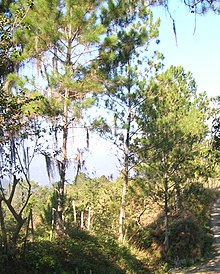Pinus occidentalis
| Pinus occidentalis | |
|---|---|

| |
| Pinus occidentalis in Jarabacoa, Dominican Republic | |
| Scientific classification | |
| Kingdom: | Plantae |
| Clade: | Tracheophytes |
| (unranked): | Gymnosperms |
| Division: | Pinophyta |
| Class: | Pinopsida |
| Order: | Pinales |
| Family: | Pinaceae |
| Genus: | Pinus |
| Subgenus: | P. subg. Pinus |
| Section: | P. sect. Trifoliae |
| Subsection: | P. subsect. Australes |
| Species: | P. occidentalis
|
| Binomial name | |
| Pinus occidentalis | |
Pinus occidentalis, also known as the Hispaniolan pine[1] or Hispaniola pine,[2] (or in Spanish: pino criollo [3]) is a pine tree endemic to the island of Hispaniola[4] (split between the Dominican Republic and Haiti).
Ecology[]
It is the eponymous species of the Hispaniolan pine forests ecosystem, in which it constitutes a majority of the biomass present.[5] Another endemic species, the Hispaniolan crossbill (Loxia megaplaga), feeds almost exclusively on the cones of P. occidentalis.[6]
References[]
- ^ a b Farjon, A. (2013). "Pinus occidentalis". IUCN Red List of Threatened Species. 2013: e.T34192A2850209. doi:10.2305/IUCN.UK.2013-1.RLTS.T34192A2850209.en.
- ^ "Pinus occidentalis / Hispaniola pine | Conifer Species". American Conifer Society. Retrieved 12 August 2020.
- ^ "Pinus occidentalis (Pino criollo) description".
- ^ Darrow, W. Kevin; Zanoni, T. (1990). "Hispaniolan pine (Pinus occidentalis Swartz): A little known sub-tropical pine of economic potential". The Commonwealth Forestry Review. 69 (2 (219)): 133–146. ISSN 0010-3381. JSTOR 43737717.
- ^ "The island of Hispaniola in the Caribbean | Ecoregions | WWF".
- ^ Dod, Annabelle Stockton (1978). Aves de la República Dominicana. Museo Nacional de Historia Natural, Santo Domingo, Dominican Republic.
Categories:
- IUCN Red List endangered species
- Pinus
- Flora of the Dominican Republic
- Flora of Haiti
- Taxa named by Olof Swartz
- Conifer stubs
